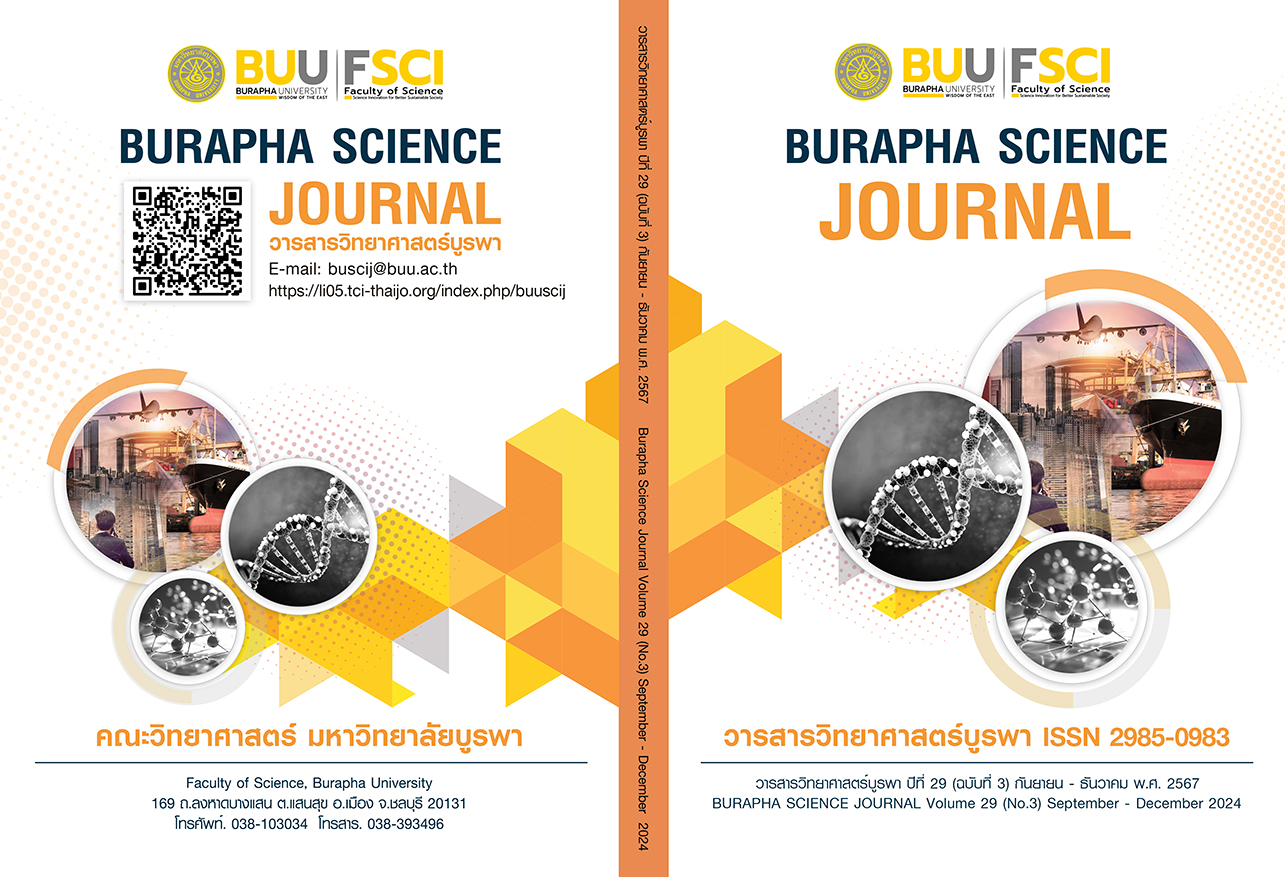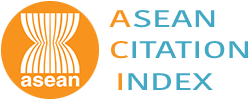ผลของถั่วเหลืองหมักด้วยแบคทีเรีย Bacillus subtillis var. natto ต่อการเจริญเติบโตของปลากะพงขาว (Lates culcarifer Bloch, 1970)
คำสำคัญ:
เชื้อบาซิลลัส , ถั่วเหลืองหมัก , แหล่งโปรตีนทดแทน , ปลากะพงขาวบทคัดย่อ
วัตถุประสงค์และที่มา : ปลากะพงขาว เป็นปลาเศรษฐกิจที่นิยมเลี้ยงกันอย่างแพร่หลายในบริเวณพื้นที่ติดชายฝั่ง จังหวัดตรังมีการเลี้ยงปลากะพงขาวในกระชัง กระจายอยู่บริเวณชายฝั่งทะเล และปากแม่น้ำ โดยใช้อาหารสำเร็จรูป และปลาสด ซึ่งการใช้อาหารสำเร็จรูป ส่งผลให้ปลามีการเจริญเติบโตที่ดี แต่ส่งผลต่อต้นทุนที่มีราคาสูง โดย เกษตรกรบางรายมีการใช้ปลาสดเป็นอาหารให้ปลากะพงขาว เนื่องจากสามารถหาซื้อปลาสดได้ในทุกวัน แต่ก็ประสบปัญหาคุณภาพของปลาสดที่มีคุณค่าทางโภชนาการหลากหลาย ไม่คงที่ ส่งผลต่อการเจริญเติบโต จึงได้หาแนวทางในการผลิตอาหารต้นทุนต่ำ โดยนำถั่วเหลืองหมักด้วยเชื้อ Bacillus subtilis var. natto ทดแทนปลาป่น เพื่อศึกษาผลต่อการเจริญเติบโต ประสิทธิภาพการใช้อาหาร และต้นทุนด้านอาหารในการเลี้ยงปลากะพงขาว
วิธีดำเนินการวิจัย : สุ่มปลากะพงขาวขนาด 37.00-38.18 กรัม เลี้ยงในกระชังขนาดยาว 2 เมตร กว้าง 1.5 เมตร ลึก 2 เมตร จำนวน 100 ตัวต่อกระชัง จำนวน 12 กระชัง อาหารทดลองมี 3 ชนิดคือ อาหารสำเร็จรูปสำหรับปลากะพงขาว (CM) อาหารผสมถั่วเหลืองหมัก (NT) และปลาสด (TF) ให้ปลากินอาหารจนอิ่มวันละ 1 มื้อ (8.00 น.) เลี้ยงเป็นระยะเวลา 160 วัน
ผลการวิจัย : น้ำหนักเฉลี่ย อัตราการเจริญเติบจำเพาะ อัตรารอด และผลผลิตปลากะพงขาวต่อกระชัง ของทุกชุดการทดลองไม่มีความแตกต่างกันอย่างมีนัยสำคัญทางสถิติ (P>0.05) ส่วน ปริมาณอาหารที่กิน อัตราแลกเนื้อ ประสิทธิภาพการใช้โปรตีน และต้นทุนค่าอาหาร มีความแตกต่างกันอย่างมีนัยสำคัญทางสถิติ (P<0.05) ปลากะพงขาวที่ได้รับอาหาร CMมีค่าปริมาณที่กินน้อยที่สุด รองลงมา เป็นปลาที่ได้รับอาหาร NT ส่วนปลาที่ได้รับอาหาร TF มีค่าปริมาณอาหารที่กินมากที่สุด อัตราแลกเนื้อของปลากะพงขาวที่ได้รับอาหาร NT ไม่แตกต่างจากปลาที่ได้รับอาหาร CM และน้อยกว่าปลาที่ได้รับอาหาร TF ประสิทธิภาพการใช้โปรตีนของปลาที่ได้รับอาหาร NT มีค่าน้อยกว่าปลาที่ได้รับอาหาร CM และ TF ปลาที่ได้รับอาหาร NT มีต้นทุนด้านอาหารน้อยที่สุด รองลงมาเป็นปลาที่ได้รับอาหาร CM ส่วนปลาที่ได้รับอาหาร TF มีต้นทุนด้านอาหารมากที่สุด
สรุปผลการวิจัย : จากผลการศึกษาพบว่าการทดลองเลี้ยงปลากะพงขาวด้วยอาหารที่ทดแทนปลาป่นบางส่วนด้วยถั่วเหลืองที่ผ่านการหมักด้วยเชื้อ B. subtilis var. natto ให้ผลต่อการเจริญเติบโต อัตรารอด และผลผลิตไม่แตกต่างจากอาหารสำเร็จรูปและปลาสด นอกจากนี้ยังสามารถลดต้นทุนด้านอาหารของปลากะพงขาวที่เลี้ยงในกระชังได้อย่างมีนัยสำคัญทางสถิติอีกด้วย
เอกสารอ้างอิง
Abd-Alrahman, A. M., Ramadan, M. M., Maraay, M. F., Salem, R., Saleh, F. M., Hashim, M. A., Zhernyakova, A., & El-Messery, T. M. (2024). Production of natural flavor compounds using Bacillus subtilis-fermented soybean meal extract and their biological potential: a comprehensive in vitro study. Frontiers in nutrition, 10, 1280209. https://doi.org/10.3389/fnut.2023.1280209
AOAC. (1990). Official Methods of Analysis (Volume 1). (15th ed). Virginia, USA Association of Official Analytical Chemists, Inc.
Basto, A., Valente, L. M. P., Sousa, V., Conde-Sieira, M., & Soengas, J. L. (2023). Total fishmeal replacement by defatted Tenebrio molitor larvae meal induces alterations in intermediary metabolism of European sea bass (Dicentrarchus labrax). Journal of animal science, 101, skad040. https://doi.org/10.1093/jas/skad040
Boonyaratpalin, M., Suraneiranat, P., & Tunpibal, T. (1998). Replacement of fish meal with various types of soybean products in diets for the Asian seabass, Lates calcarifer. Aquaculture, 161(1-4), 67-78.
Boonyaratpalin, M. , & Williams, K. (2002). Asian Sea Bass, Lates calcarifer. In Webster, C. D. & Lim, C. E. eds. Nutrient Requirements & Feeding of Finfish for Aquaculture. (pp.40-50). Alabama, USA. CABI Publishing.
Chen, L., Madl, R. L., Vadlani, P. V., Li, L., & Wang, W. (2013). Value-added products from soybean: removal of anti-nutritional factors via bioprocessing. Soybean: a review, 161-179. https://www.intechopen.com/chapters/42947
Daniel, N. (2018). A review on replacing fish meal in aqua feeds using plant protein sources. International Journal of Fisheries and Aquatic Studies, 6(2), 164-179.
Drew, M. D., Borgeson, T. L., & Thiessen, D. L. (2007). A review of processing of feed ingredients to enhance diet digestibility in finfish. Animal Feed Science and Technology, 138(2), 118-136.
Fisheries Statistics Group. (2023). Statistics of Marine Fish Farms Survey 2022. Fisheries Development Policy and Planning Division, Department of Fisheries, Ministry of Agriculture and Cooperatives. 37p.
Glencross, B., Blyth, D., Irvin, S., Bourne, N., Campet, M., Boisot, P., & Wade, N.M. (2016). An evaluation of the complete replacement of both fishmeal and fish oil in diets for juvenile Asian seabass, Lates calcarifer. Aquaculture, 451, 298-309.
Hamidoghli, A., Won, S., Farris, N. W., Bae, J., Choi, W., Yun, H., & Bai, S. C. (2020). Solid state fermented plant protein sources as fish meal replacers in white leg shrimp Litopaeneus vannamei. Animal Feed Science and Technology, 264, 114474. https://doi.org/10.1016/j.anifeedsci.2020.114474
He, M., Yu, Y., Li, X., Poolsawat, L., Yang, P., Bian, Y., Gou, Z., & Leng, X. (2020). An evaluation of replacing fish meal with fermented soybean meal in the diets of largemouth bass (Micropterus salmoides): Growth, nutrition utilization and intestinal histology. Aquaculture Research, 51(10), 4302-4314.
Li Z. J., Chen Y. H., Zhang J. Z., Zhu X., Zhang J. S., Chen D. X., Wang K. Z., Hu Y., & Chu W. Y. (2017). Effects of dietary Bacillus natto supplementation on growth performance and the growth related gene microRNA expression in the skeletal muscle of grass carp (Ctenopharyngodon idella). Aquaculture Nurtrition, 23(1), 46-53.
Liu C.H., Chiu C. H., Ho P. L. , & Wang S. W. (2009). Improvement in the growth performance of white shrimp, Litopenaeus vannamei, by a protease-producing probiotic, Bacillus subtilis E20, from natto. Journal of Applied Microbiology, 107, 1031–1041.
Mundheim, H., Aksnes, A., & Hope, B. (2004). Growth, feed efficiency and digestibility in salmon (Salmo salar L.) fed different dietary proportions of vegetable protein sources in combination with two fish meal qualities. Aquaculture, 237(1-4), 315-331.
Nandakumar, S., Ambasankar, K., Dayal, J. S., Raman, C., & Ali, S. R. (2013). Fish meal replacement with chicken waste meal in Asian seabass (Lates calcarifer) feeds. Indian J. Fish, 60(2), 109-114.
Petersen E. H., Chinh D.T.M., Diu N.T., Phuoc V.V., Phuong T.H., Dung N.V., Dat N.K., & Giang P.T. (2011). Bioeconomics of Asian seabass, Lates calcarifer, culture in Vietnam. Available at https://www.researchgate.net/publication/265277722.
Plaipetch, P., Tamtin, M., Chaikul, S. L., Kuekaew, J., Muengyao, P., Samranrat, N., & Thongrod, S. (2008). Comparison on growth performance and meat quality of sea bass fed with trash fish and pellets. In Proceedings of the 45th Kasetsart University Annual Conference. (pp. 156-166). Bangkok, Thailand : Kasetsart University.
Plaipetch, P. (2014). Advances in Nutritional researches on Asian sea bass, Lates calcarifer (Bloch, 1790). KKU Res. J., 19(4), 571-584.
Plaipetch P., Kuekaew, J., Tamtin, M., & Choncheunchob, P. (2014). Effect of low dietary fishmeal on Growth, Nitrogen Loading and Some Physical and Chemical Indices of Asian Sea Bass Lates calcarifer (Bloch, 1790). Kasetsart J.(Nat.Sci.), 48, 1-11.
Phumee, P., & Koedprang, W. (2024). Replacement of Fish Meal with a Combination of Fermented Fish and Soybean Meal in the Diet of Juvenile Asian Seabass, Lates calcarifer (Bloch, 1790). Journal of Fisheries & Environment, 48(1), 168-174.
Phumee, P., Wei, W. Y., Ramachandran, S., & Hashim, R. (2011). Evaluation of soybean meal in the formulated diets for juvenile Pangasianodon hypophthalmus (Sauvage, 1878). Aquaculture Nutrition, 17(2), 214-222.
Rana, K. J., Siriwardena, S., & Hasan, M. R. (2009). Impact of rising feed ingredient prices on aquafeeds and aquaculture production. In FAO (Ed.), Fisheries and Aquaculture Technical Paper. (pp. xii+-63). Rome, Italy: Food, Agriculture Organization of the United Nations. doi/full/10.5555/20103269836
Rahimnejad, S., Zhang, J. J., Wang, L., Sun, Y., & Zhang, C. (2021). Evaluation of Bacillus pumillus SE5 fermented soybean meal as a fish meal replacer in spotted seabass (Lateolabrax maculatus) feed. Aquaculture, 531, 735975. doi.org/10.1016/j.aquaculture.2020.735975
Rahimnejad, S., Lu, K., Wang, L., Song, K., Mai, K., Davis, D. A., & Zhang, C. (2019). Replacement of fish meal with Bacillus pumillus SE5 and Pseudozyma aphidis ZR1 fermented soybean meal in diets for Japanese seabass (Lateolabrax japonicus). Fish & Shellfish Immunology, 84, 987-997.
Ruiz Sella, S.R.B., Bueno, T., de Oliveier, A.A.B., Karp, S.G., & Soccol, C.R. (2021). Bacillus subtilis natto as a potential probiotic in animal nutrition. Critical Reviews in Biotechnology, 41(3), 355-369. Doi.org/10.1080/07388551.2020.1858019.
Sharma, S., Goyal, R., & Barwal, S. (2013). Domestic processing effects on physicochemical, nutritional and anti-nutritional attributes in soybean (Glycine max L. Merill). International Food Research Journal, 20(6), 3203-3209.
Thompson, K. R., Rawles, S. D., Metts, L. S., Smith, R. G., Wimsatt, A., Gannam, A. L., Twibell, R. G., Johnson, R. B., Brady, Y. J., & Webster, C. D. (2008). Digestibility of dry matter, protein, lipid, and organic matter of two fish meals, two poultry by-product meal, soybean meal, and distiller’s grains with solubles in practical diets for Sunshine bass, Morone chrysops × M. saxatillis. J. World Aquaculture. Society, 39(3), 352-363.
Weng T. M. , & Chen M. T. (2010). Changes of protein in natto (a fermented soybean food) affected by fermenting time. Food Sci. Technol. Res.,16(6), 537-542.
Wiseso, N., Chainark, P. , & Rattana, W. (2021). Fish meal replacement with alternative protein sources in sea bass, Lates calcarifer (Bloch,1790) diet. Technical paper No.8/2021.Coatal Aquaculture Research and Development Division, Department of Fisheries, Ministry of Agriculture and Cooperatives. (in Thai)
Yanti, M., Dewiyanti, I., Nurfadhilah, N., Nur, F.M., Batubara, A.S., Tahang, M., & Muchlisin, Z.A. (2019). Replacement of fishmeal with soybean meal for the diet of seabass, Lates cacarifer. IOP Conf. Series: Earth and Environmental Science. 348: 012105. DOI: 10.1088/1755-1315/348/1/012105
ดาวน์โหลด
เผยแพร่แล้ว
รูปแบบการอ้างอิง
ฉบับ
ประเภทบทความ
สัญญาอนุญาต
ลิขสิทธิ์ (c) 2024 คณะวิทยาศาสตร์ มหาวิทยาลัยบูรพา

อนุญาตภายใต้เงื่อนไข Creative Commons Attribution-NonCommercial-NoDerivatives 4.0 International License.
Burapha Science Journal is licensed under a Creative Commons Attribution-NonCommercial-NoDerivatives 4.0 International (CC BY-NC-ND 4.0) licence, unless otherwise stated. Please read our Policies page for more information




